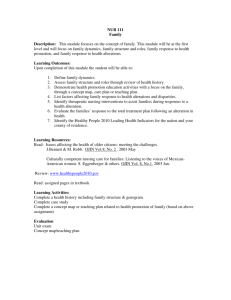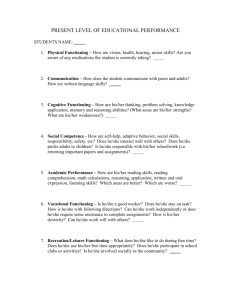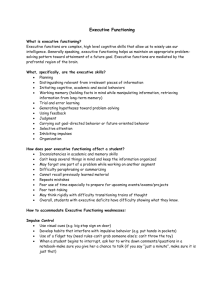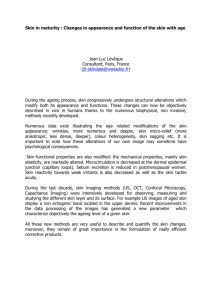Table of Contents - Institute of Healthcare Professions
advertisement
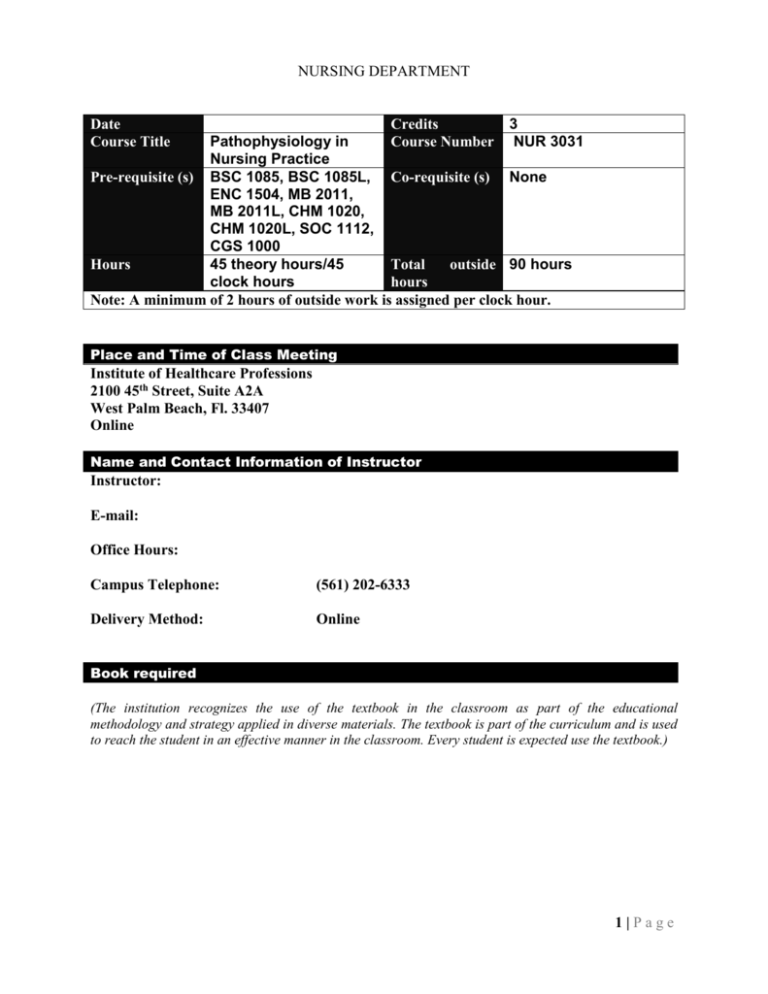
NURSING DEPARTMENT Date Course Title Credits Course Number 3 NUR 3031 Pathophysiology in Nursing Practice Pre-requisite (s) BSC 1085, BSC 1085L, Co-requisite (s) None ENC 1504, MB 2011, MB 2011L, CHM 1020, CHM 1020L, SOC 1112, CGS 1000 Hours 45 theory hours/45 Total outside 90 hours clock hours hours Note: A minimum of 2 hours of outside work is assigned per clock hour. Place and Time of Class Meeting Institute of Healthcare Professions 2100 45th Street, Suite A2A West Palm Beach, Fl. 33407 Online Name and Contact Information of Instructor Instructor: E-mail: Office Hours: Campus Telephone: (561) 202-6333 Delivery Method: Online Book required (The institution recognizes the use of the textbook in the classroom as part of the educational methodology and strategy applied in diverse materials. The textbook is part of the curriculum and is used to reach the student in an effective manner in the classroom. Every student is expected use the textbook.) 1|Page NURSING DEPARTMENT Title: Pearson Reviews& Rationales: Pathophysiology with “Nursing Review Author : Mary Ann Hogan ISBN-10: 0133249778 • ISBN-13: 9780133249774 ©2013 / Prentice Hall Classroom expectations for students Attendance Policy IHP has adopted a revised online attendance policy which requires students to be actively participating in their online course to be considered in attendance. Students are expected to participate in all required instructional activities in their courses. Online courses are no different in this regard; however, participation must be defined in a different manner. 1. Student “attendance” in an online course is defined as active participation in the course as described in the course syllabus. Instructors in online courses are responsible for providing students with clear instructions for how they are required to participate in the course. Additionally, instructors are responsible for incorporating specific instructional activities within their course and will, at a minimum, have weekly mechanisms for documenting student participation. These mechanisms may include, but are not limited to, participating in a weekly discussion board, submitting/completing assignments in the online platform, or communicating with the instructor. 2. Students aware of necessary absences must inform the professor with as much advance notice as possible in order to make appropriate arrangements. 3. Any student absent 20 percent or more of the online course, i.e., non-participatory during 3 or more weeks of an 11 week term, may receive an F for that course. 4. Any student who has not actively participated in an online class prior to the census date for any given term is considered a "no-show" and will be administratively withdrawn from the class without record. To be counted as actively participating, it is not sufficient to log in and view the course. The student must be submitting work as described in the course syllabus. 5. Additional attendance and participation policies for each course, as defined by the instructor in the course syllabus, are considered a part of the attendance policy 2|Page NURSING DEPARTMENT Any questions regarding this policy may be directed to the Director of Education. NOTE: Plagiarism is defined as the use, without proper acknowledgment, of the ideas, phrases, sentences, or larger units of discourse from another writer or speaker. Plagiarism includes the unauthorized copying of software and the violation of copyright laws. Students who commit plagiarism will obtain a grade of “Failure” on their exam or assignment. Course Description (must correspond exactly to Catalog description) The focus of the course is on the pathogenesis of selected diseases leading to alterations of body structure and functions across the lifespan. This is emphasized through case study review discussing and applying cell structure, function, genetic control and its impact on the disease process. The students will integrate and apply pathophysiological concepts to primary, secondary, and tertiary interventions. Alternative and traditional treatment modalities pertinent to common diseases and disorders will be explored. Learning Objectives Upon successful completion of this course, the student will be able to: Explain altered cellular function Describe the role of genetics in disease Recognize alterations caused by inflammation Recognize alterations caused by infection Recognize alterations in hematologic functions Recognize alterations in lymphatic functions Recognize alterations in neurologic functions Recognize alterations in endocrine functions Recognize alterations in urinary functions Recognize alterations in cardiovascular functions Recognize alterations in pulmonary functions Recognize alterations in digestive functions Recognize alterations in reproductive functions Recognize alterations in musculoskeletal functions Recognize alterations in integumentary functions Apply pathophysiologic knowledge in nursing practice to a given clinical situation Topical Outline and Schedule DATE WEEK 1 At the end of this lesson, the student will be able to: SPECIFIC OBJECTIVES Recognize altered cell functioning Recognize conditions caused by genetic disorders 3|Page NURSING DEPARTMENT TOPIC (S) LEARNING ACTIVITIES OUTSIDE WORK & ASSIGNED READINGS Recognize mechanisms of cellular injury Recognize acid-base imbalances Describe risk factors for development of cancer Explain the process of infections Describe the function of the immune system Explain the response of the immune system to inflammation Describe the relationship between inflammation and cancer development Cellular Function and Genetics Inflammation, Immunity and Infection READING ASSIGNMENTS: VIEW Online Lesson Presentations DISCUSSION Discussion of Syllabus Discussion topic Discussion 1.1: Introductions Discussion 1.2: Genetic Disease Occurrence Discussion 2.1: Inflammation and the Immune System ASSIGNMENT Review the Syllabus Read assignments Post discussion Complete the online Library Orientation Assignment 1.1: Cancer Risk Factors Assignment 2.1: The Process of Infections Assignment 2.2: Inflammation and Cancer ASSESSMENTS Quiz 1 Quiz 2 Homework: Read: Chapters DATE WEEK 2 At the end of this lesson, you will be able to: SPECIFIC OBJECTIVES Describe alterations in hematologic functioning Identify clinical manifestations associated with hematologic disorders Analyze hematologic system disorders across the lifespan Describe alterations in lymphatic functioning 4|Page NURSING DEPARTMENT TOPIC (S) LEARNING ACTIVITIES Identify clinical manifestations associated with lymphatic disorders Analyze lymphatic system disorders across the lifespan Describe alterations in neurologic functioning Identify clinical manifestations associated with specific disease processes of the neurologic system Analyze neurologic system disorders across the lifespan The Hematologic and Lymphatic Systems The Neurologic System READING ASSIGNMENTS VIEW Online Lesson Presentations OUTSIDE WORK & ASSIGNED READINGS DISCUSSION Discussion topic Discussion 3.1: Common Alterations in Hematologic Functioning Discussion 3.2: Common Alterations in Lymphatic Functioning Discussion 4.1: Common Alterations in Neurologic Functioning ASSIGNEMNTS Complete discussion questions Assignment 3.1: Types of Anemia Assignment 3.2: Acute and Chronic Leukemia Assignment 4.1: Neurologic Disorders ASSESSMENT Discussion post Quiz 3 Quiz 4 Homework: Read: Chapters DATE WEEK 3 At the end of this lesson, you will be able to: SPECIFIC OBJECTIVES Describe alterations in endocrine functioning Identify clinical manifestations associated with specific disease processes of the endocrine system Analyze endocrine system disorders across the lifespan Describe mechanisms of hormonal regulation 5|Page NURSING DEPARTMENT TOPIC (S) LEARNING ACTIVITIES OUTSIDE WORK & ASSIGNED READINGS DATE SPECIFIC OBJECTIVES The Endocrine System READING ASSIGNMENTS VIEW Online Lesson Presentation DISCUSSION Discussion topic Discussion 5.1: Common Alterations in Endocrine Function ASSIGNMENTS Read assignments Complete discussion question Post response Assignment 5.1: Endocrine-Related Disorders ASSESSMENT Discussion post Quiz 5 Homework: Read: Chapters WEEK 4 At the end of this lesson, you will be able to: TOPIC (S) LEARNING ACTIVITIES OUTCOME WORK & ASSIGNED READINGS Describe alterations in urinary functioning Identify clinical manifestations associated with specific disease processes of the urinary system Analyze urinary system disorders across the lifespan The Urinary System READING ASSIGNMENTS VIEW Online Lesson Presentation DISCUSSION Discussion topic Discussion 6.1: Common Alterations in Urinary Functioning ASSIGNMENTS Read assignments Complete discussion question Assignment 6.1: Urinary System Disorders Post response ASSESSMENT Discussion post Quiz 6 Homework: 6|Page NURSING DEPARTMENT Read: Chapters Prepare for Midterm DATE WEEK 5 At the end of this lesson, you will be able to: SPECIFIC OBJECTIVES Describe alterations in cardiovascular functioning Identify clinical manifestations associated with specific disease processes of the cardiovascular system Analyze cardiovascular system disorders across the lifespan TOPIC (S) The Cardiovascular System READING ASSIGNMENTS: OUTSIDE WORK & ASSIGNED READINGS VIEW Online Lesson Presentation DISCUSSION Discussion topic Discussion 7.1: Common Alterations in Cardiovascular Functioning ASSIGNMENTS Read assignments Complete discussion topic Assignment 7.1: Cardiovascular System Disorders Post response ASSESSMENT Discussion post Quiz 7 Midterm example covering weeks 1-4 Homework: Read: Chapters DATE WEEK 6 At the end of this lesson, you will be able to: SPECIFIC OBJECTIVES Describe alterations in pulmonary functioning Identify clinical manifestations associated with specific disease processes of the pulmonary system Analyze pulmonary system disorders across the lifespan TOPIC (S) LEARNING The Pulmonary System READING ASSIGNMENTS: 7|Page NURSING DEPARTMENT ACTIVITIES OUTSIDE WORK & ASSIGNED READINGS VIEW Online Lesson Presentation DISCSSION Discussion Discussion 8.1: Common Alterations in Pulmonary Functioning ASSIGNMENTS Read assignments Complete discussion question Post response Assignment 8.1: Pulmonary System Disorders ASSESSMENT Discussion post Homework: Read: Chapters DATE WEEK 7 At the end of this lesson, you will be able to: SPECIFIC OBJECTIVES Describe alterations in digestive functioning Identify clinical manifestations associated with specific disease processes of the digestive system Analyze digestive system disorders across the lifespan TOPIC (S) LEARNING ACTIVITIES The Digestive System READING ASSIGNMENTS: VIEW Online Lesson Presentation OUTSIDE WORK & ASSIGNED READINGS DISCUSSION Discussion 9.1: Common Alterations in Digestive Functioning ASSIGNMENTS Reading assignments Complete discussion question Post response Assignment 9.1: Digestive System Disorders ASSESSMENT Discussion post Quiz 9 Homework: Read: Chapters DATE WEEK 8 8|Page NURSING DEPARTMENT At the end of this week, you will be able to: SPECIFIC OBJECTIVES Describe alterations in reproductive functioning Identify clinical manifestations associated with specific disease processes of the reproductive system Analyze reproductive system disorders across the lifespan Describe alterations in musculoskeletal functioning Describe alterations in integumentary functioning Identify clinical manifestations associated with specific disease processes of the musculoskeletal system Identify clinical manifestations associated with specific disease processes of the integumentary system Analyze musculoskeletal system disorders across the lifespan Analyze integumentary system disorders across the lifespan TOPIC (S) LEARNING ACTIVITIES OUTSIDE WORK & ASSIGNED READINGS The Reproductive System The Musculoskeletal and Integumentary Systems READING ASSIGNMENTS: VIEW Online Lesson Presentations DISCUSSIONS: Discussion 10.1: Common Alterations in Reproductive Functioning Discussion 11.1: Common Alterations in Musculoskeletal Functioning Discussion 11.2: Common Alterations in Integumentary Functioning ASSIGNMENTS Assignment 10.1: Reproductive System Disorders Assignment 11.1: Musculoskeletal System Disorders Assignment 11.2: Burns ASSESSMENT Quiz 10 Quiz 11 Homework: Prepare for Final Exam DATE WEEK 9 At the end of this week, you will be able to: SPECIFIC OBJECTIVES Identify stress-related diseases and conditions Recognize the stress response in disease occurrence Recognize signs and symptoms of developing shock Describe the causes of Multiple Organ Dysfunction Syndrome Describe the clinical manifestations of Multiple Organ Dysfunction 9|Page NURSING DEPARTMENT Syndrome TOPIC (S) LEARNING ACTIVITIES OUTSIDE WORK & ASSIGNED READINGS DATE TOPIC (S) Application of Pathphysiology Concepts READING ASSIGNMENTS DISCUSSION: Discussion 12.1: Shock and Multiple Organ Dysfunction Syndrome ASSIGNMENTS: Assignment 12.1: The Stress Response ASSESSMENT Quiz 12 Prepare for Final WEEK 10 Final Exam covering weeks 5-9 Instructional Methods The following strategies may be used in this class: 1. Reading assignments 2. Discussion threads 3. Quizzes 4. Midterm exam 5. Final exam 6. Internet research 7. Critical thinking assignments 8. Student evaluation of course References and Resources Medline Plus http://www.nlm.nih.gov/medlineplus/ Health information from the National Library of Medicine National Institutes of Health. Easy access to health topics, medical dictionaries, directories, drug information, videos and more. Full-text electronic journal articles at lirn.net Click on “Databases” access code 40149 select “Connect to ProQuest” There you will find full text health and medical information from Joanna Briggs Institute, the Nursing and Allied Health Collection, Health & Medical Complete, and Psychology Journals. 10 | P a g e NURSING DEPARTMENT PALM BEACH COUNTY LIBRARY ONLINE RESOURCES You need a free Palm Beach County Library card to access, or register for a free “Temporary Research Access Code” at http://edb.pbclibrary.org/TRAC/ If you need help using any of the library websites, click on the “Ask a Librarian” icon and “chat” with a librarian. Consumer Health http://www.pbclibrary.org/consumer-health.htm CINAHL® with Full Text - full text articles for more than 610 nursing and allied health journals as well as health care books, nursing dissertations, selected conference proceedings, and more. http://www.pbclibrary.org/online-research LearningExpress - Take online practice tests for Health Careers, Radiography, NCLEXPN and NCLEX-RN. Learn techniques for job searching, resumes, interviewing and workplace skills. http://www.pbclibrary.org/online-research Health and Wellness Resource Center http://www.pbclibrary.org/online-research Assessment Criteria and Methods of Evaluating Students 90 – 100% 80 – 89% 70 – 79% < 75% A B C F Do not count on a curve! Generally, the grades “A” through “C-” are considered passing grades. Grades "W" and "I" indicate that no grades were earned for the course. A "W" grade indicates that the student withdrew from the course. An "I" grade indicates that the student was passing the course, but failed to complete all the required course work. The instructor, in his/her discretion may grant an "I" grade instead of an "F", pending completion of the course work by the student within a specified time arranged by the instructor and told to the student. It is the student's responsibility to follow-up with the instructor to complete the course work. If the course work is not completed by the arranged time, the “I” grade becomes an “F". Distribution of Grade Elements Discussion 20% Assignments 20% Quizzes: 20% Midterm: 20% 11 | P a g e NURSING DEPARTMENT Final exam: Total: 20% 100 % Date Syllabus Was Last Reviewed: January 12, 2015 12 | P a g e
